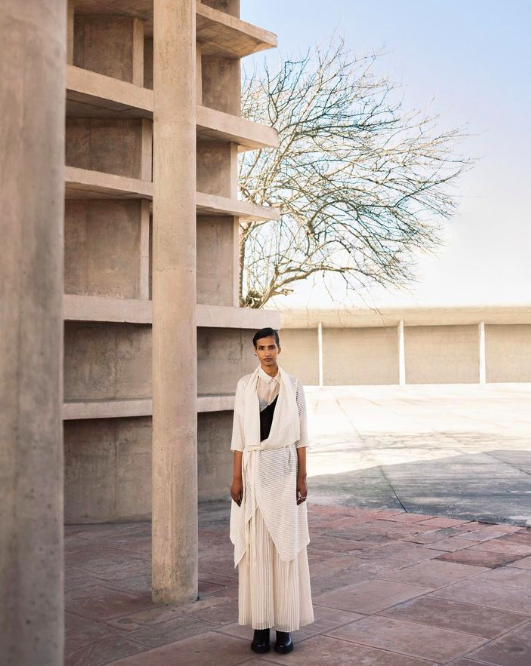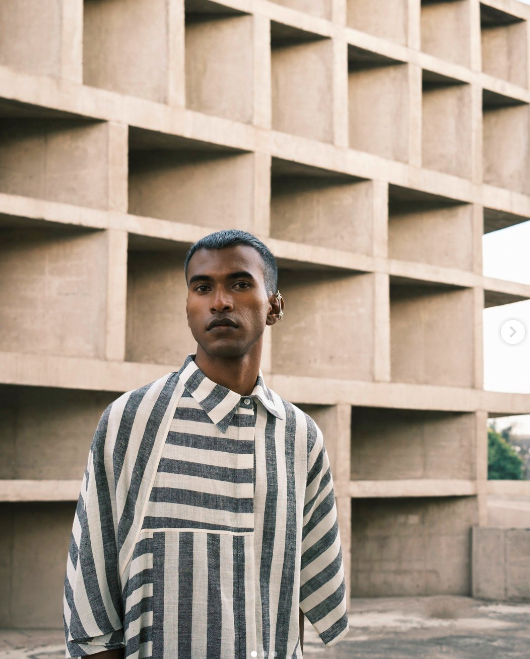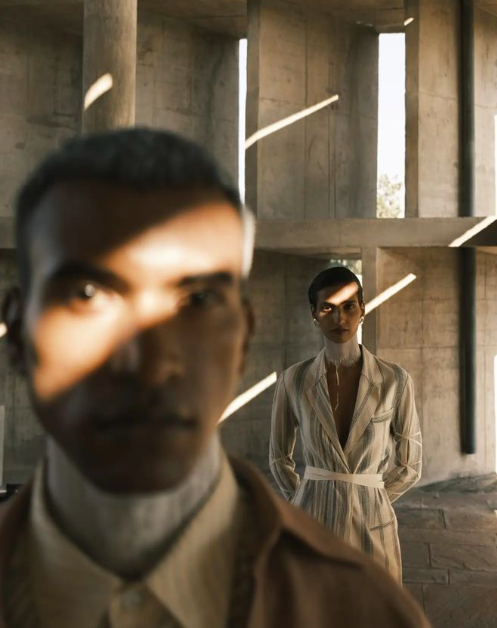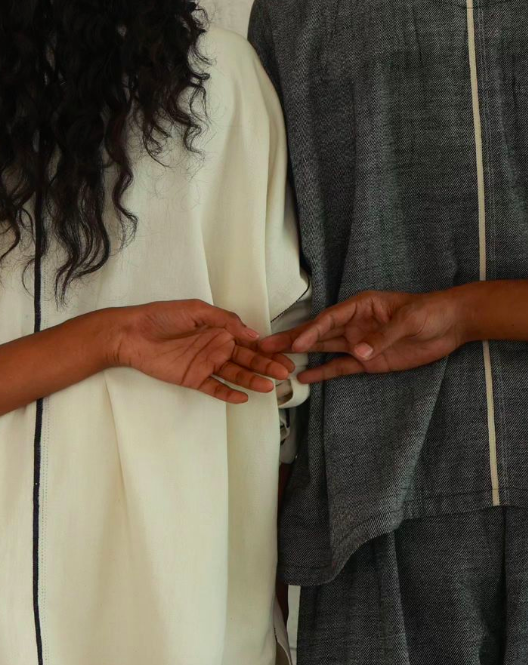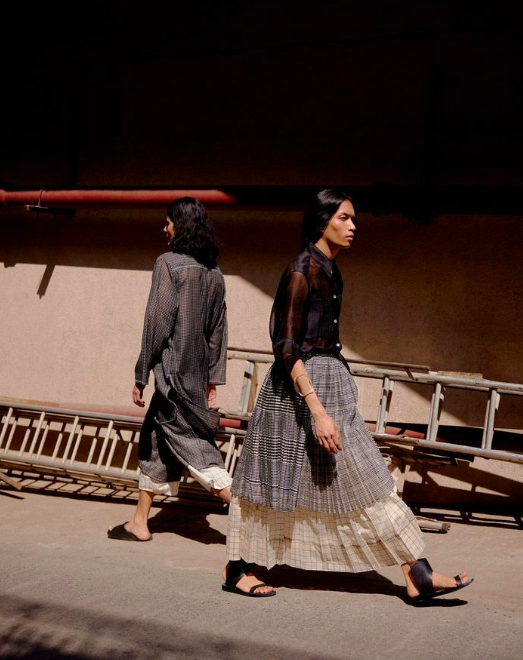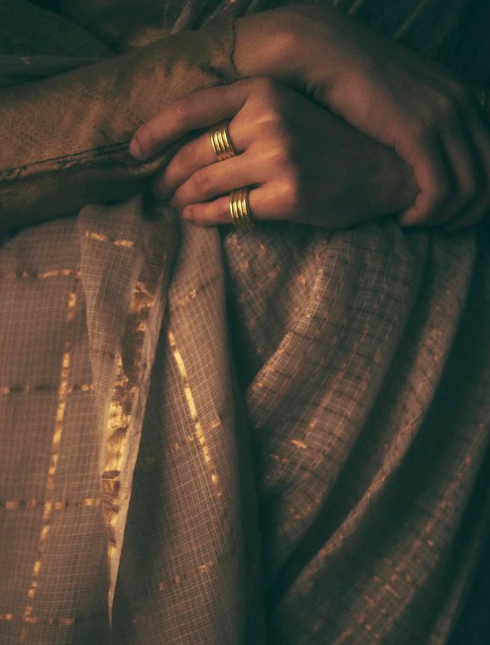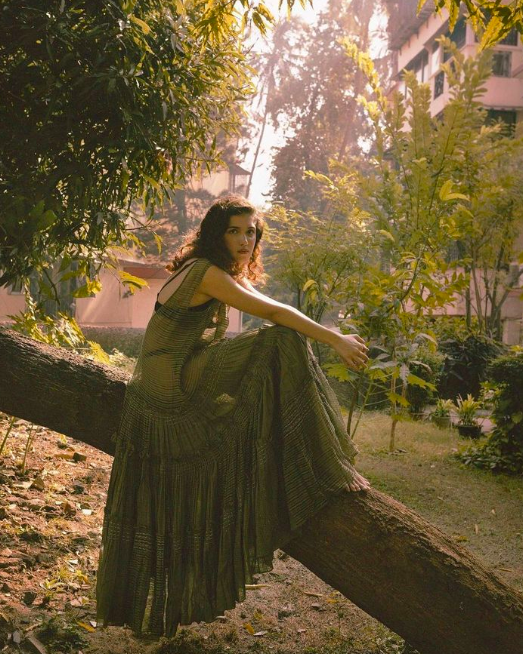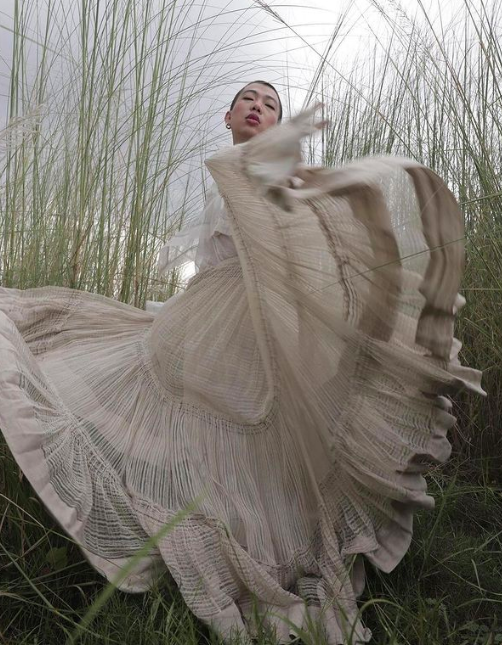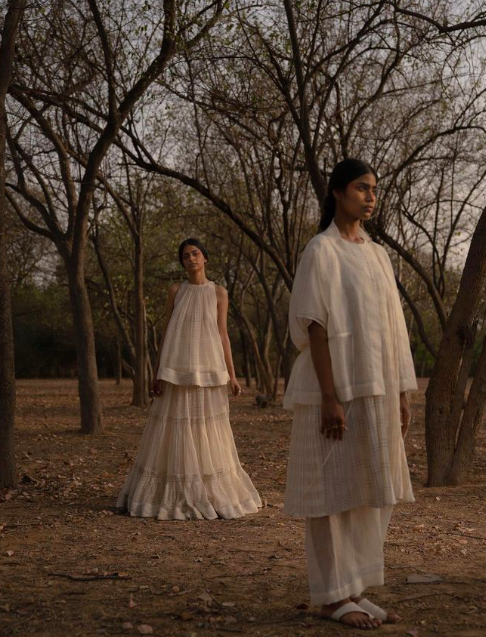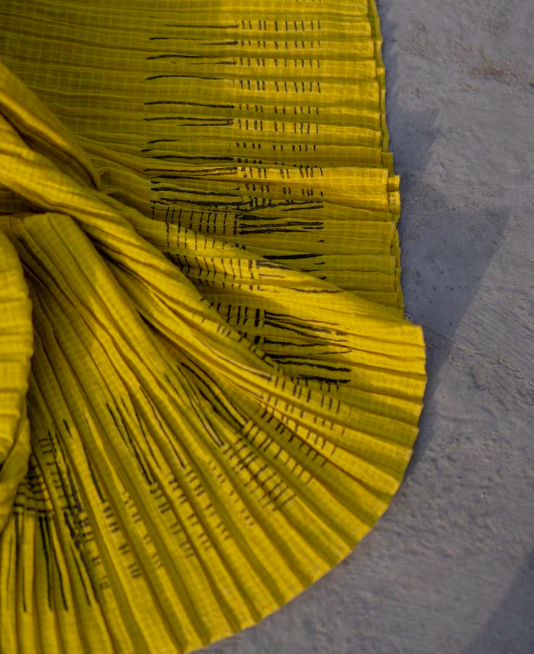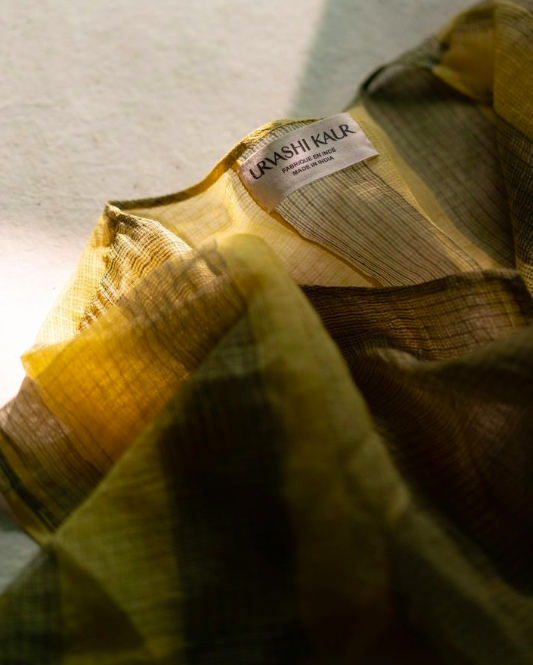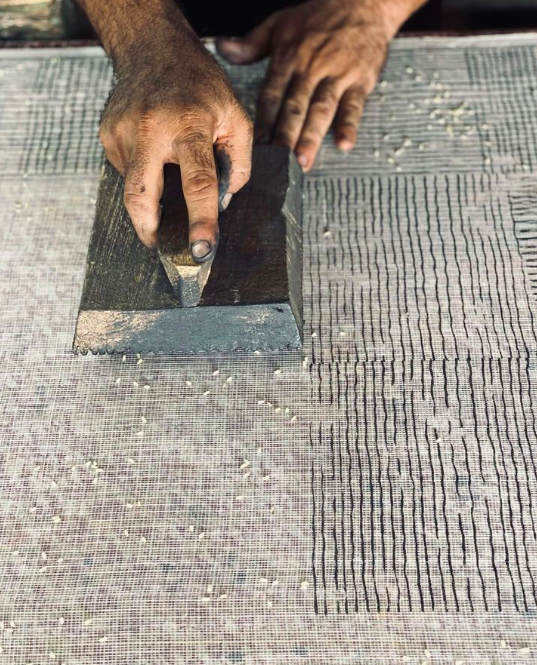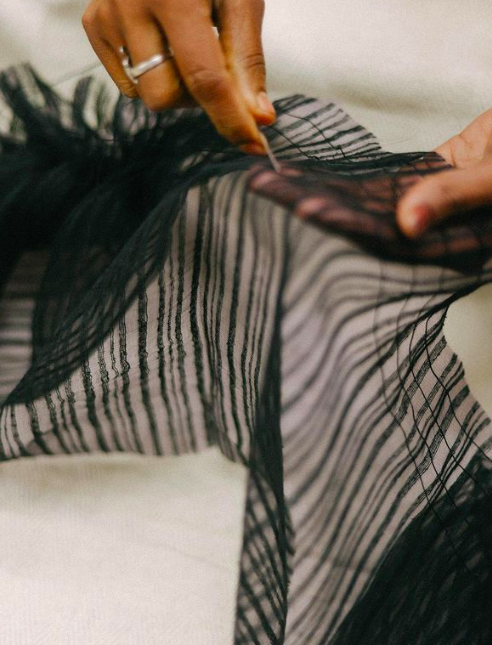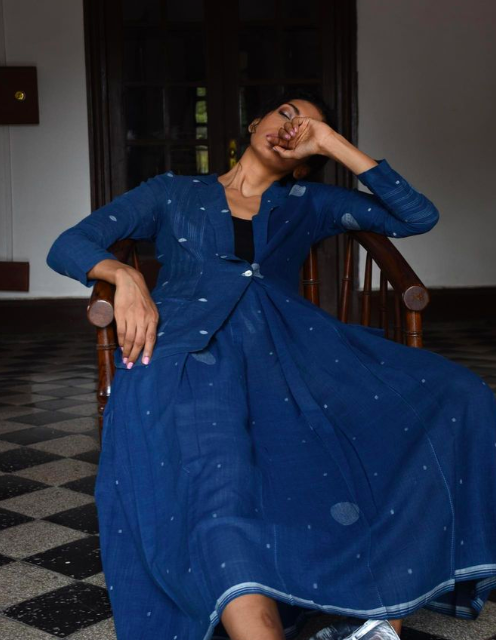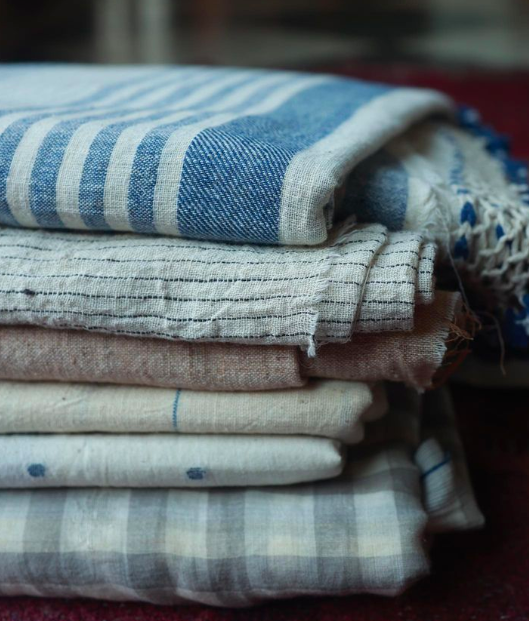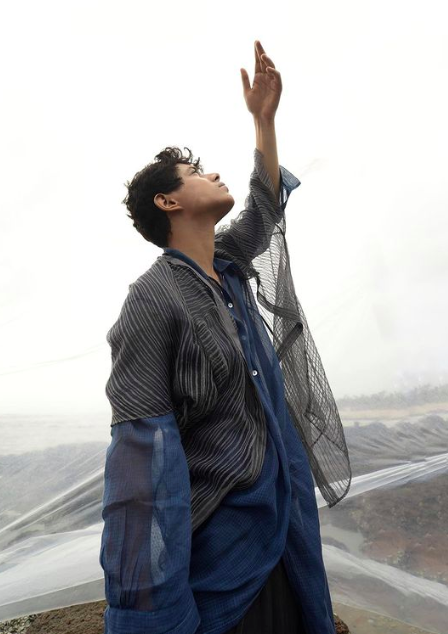In conversation with Urvashi Kaur
Unconventional, trans-seasonal fabrics, drapes, cuts, and textures, layering, contemporary interpretations of traditional skirts and dhotis, and gender fluidity are some of the key elements in your collections. Do you think that the evolving Indian fashion culture has opened an avenue for self-expression among consumers? Is this helping in diverting the focus from premium luxury fashion houses towards a more decentralized and personal definition of luxury?
The fashion industry had already been at the receiving end of much criticism. Often viewed as superficial, vain and extraneous, the fact that we are one of most polluting industries did us no favors and well before Covid, fashion already had some serious thinking to do. The silver lining in all this is the fact that somewhere along the way, sustainability and the discussion around healthier practices within the business of fashion had started taking root. Ethical fashion as a movement is now recognised as a mainstream feature, from being a humble, fringe phenomenon. Our tendency at a time like this is of course to question the relevance of anything that’s considered even mildly superfluous. But this is where it gets interesting.
Fashion at its core, is related to the most fundamental act of self-expression and identity. It is perhaps the most powerful function of self care. As long as we feel the need to express ourselves, we will need fashion since the desire to convey emotion and communicate through the act of clothing is inherent and hard wired in humans. But the processes and channels that we have built into the business of fashion, in the same way as all large industries, are deeply flawed. With fast fashion jeopardizing individuality, the lack thereof affects the consumer’s wellbeing. Big fashion houses also push conservative popular aesthetics focusing more on garnering bigger sales and creating inclusive and authentic designs.
As the world looked inwards, so did the homegrown industry. Younger homegrown brands have a larger space to thrive and a platform to influence and push a new narrative. Digital media has helped hugely in democratizing the discussion, serving as a catalyst for the evolution of fashion culture on a global scale, and thus, India. We are now witnessing thought-provoking discussions celebrating the voices of mindful creators and consumers. More inclusive and conscious brands are finding growing resonance with Indian consumers. We are also seeing a renaissance of sorts, where slowly fashion businesses will get disenchanted by the incessant need to grow and will shift focus to nurturing their supply chains and their human capital, whilst limiting production to smaller batches.
Being at the forefront of the conscious luxury narrative since long before it enjoyed widespread acceptance post covid, the unspoken social impact we recognised was in creating inclusive sizing and ungendered silhouettes and transeasonal collections. Weaving a neutral canvas of artisanal textiles and techniques to change how our clients feel, creating clothing which wears like a second skin – a true representation of their identity; cultural, personal, ethnic and beyond. The antifit conversation also resonates with one of the brand’s core beliefs, comfort. With our conscious reinvention and design innovation, each silhouette offers true versatility across seasons, sizes, age and identities.
Our dhotis/salwars/ sari blouses/angrakha and reimaginations of traditional lungis responded to the consumer seeking to express themselves and their racial identity, in the face of cultural dissociation stemming from globalization; an overwhelming consequence of the very social media which empowered the consumer post covid. A homogenized global fashion aesthetic decimated the diversity and richness of other forms of fashion expression and suppressed the continuity of local artisanal and heritage crafts traditions. Our debut on social media simply echoed the ethos of our brand; un-subjugating women and men from the man’s gaze; subverting beauty constructs and expectations by representing Indians from diverse backgrounds in our campaigns; celebrating the body our clothing houses by enabling our consumers to feel good and express through our clothes.
As we cycle back to this mindfulness, we are now seeing the definition of luxury revert from being indulgent wasteful purchases to ethically handcrafted clothing and textile. While luxury is defined as the opposite of a necessity – a great comfort or elegance, especially when involving great expense, a growing consumer base is expanding the scope of what is classified as luxury. I believe consciously crafted clothes are like heirlooms meant to have patronage and treasured as they pass down the cultural and historical legacy of our communities. In my opinion today's consumer would spend more on a product if it came from a “sustainable” brand. This reflects today's consumer's desire to buy responsibly and patronize brands which not only honor fair trade practices but also practice ancient craft traditions that celebrate our indigenous design aesthetics. Luxury is handcraft, luxury is longevity, it is eco-design.
Cultures, identities, and climates are changing rapidly. Do you think that the definitions of ‘sustainability’ and ‘artisanal’ are also constantly evolving? How will this impact the conscious luxury fashion industry?
As the recurrence of the words ‘artisanal’ and ‘sustainable’ rises with the recent shift in the paradigm towards conscious fashion, we seek to understand their definitions in the truest spirit before we can understand the implications of an evolution in their definitions. Often correctly attributed and sadly misattributed more often than not in the larger narrative controlled by fast fashion brands and relentless marketing of disinformation. Absolving themselves of any responsibility with blatant lip service designed to upsell an infinitesimal capsule which may be “more sustainable” in comparison to the nearly disposable quality of their mass-manufactured staples and exploit loopholes in any legislation with clever jargon, barring any attempt to comply at all.
According to UNESCO’s definition of the word ‘artisanal’, the inherent quality of an ‘artisanal’ product is legacies of skill and artistry being crafted into existence representing the artisan’s individual and collective identity as a part of a larger craft cluster. Cultural traditions have always been infused with artisanal products, inseparable from the culture of fashion, however only recently are we experiencing it shape the definition of sustainability.
As a major contributor to the climate and cultural crisis, it's crucial to broaden the definition of 'sustainability' to hold the fashion industry accountable. Unbiased organizations globally are mapping the fashion industry's 'sustainability' using robust metrics, with the UN's 17 Sustainable Development Goals being a key framework. When fashion genuinely supports traditional 'artisanal' crafts, it significantly contributes to achieving at least half of these goals. This includes cultivating indigenous materials responsibly, using local restorative farming practices and empowering marginalized communities. These efforts address environmental, economic, and social aspects, and the definition of 'sustainability' is now evolving to include cultural, gender, and ethnic considerations.
Brands adopting eco-friendly practices and supporting artisan communities are gaining more attention. These conscious luxury labels, although pricier, reflect the effort and dignity of collaborative craftsmanship. They disrupt traditional supply chains by reaching remote villages. The challenge is to balance marketing for visibility with encouraging responsible consumer choices to reduce the industry's impact. Consumers, becoming more discerning, opt for brands that support sustainable practices and cultural legacy, avoiding wasteful clothing. It's crucial not to perpetuate harmful cycles. Artisanal labor faces exploitation due to hand production's longer hours and higher costs. Hoping that timeless slow design prevails. Although fashion is more accepting of gender identities, there's still a long way from holistic societal acceptance. Inclusive and culturally-nuanced design gains traction as it challenges cultural appropriation by respecting the craft’s sensitivity to their deeper meaning or their relationship to the values and beliefs of the culture they originate from.
The rapid growth of throwaway culture in recent decades has benefited exploitative capitalist businesses, ironically revealing the fickleness of the industry's past.. As fast fashion giants thrived, local tailors struggled. It's time for systematic change because, ultimately, we have no other choice. Globally, consumers need to demand accountability from brands, considering all aspects of sustainability and choosing clothing made with care and tradition. Currently, we mostly see and hear of the environmental impact, but if not addressed, there will be severe consequences in the supply chain and consumer well-being. Fast fashion and trends like OOTD, often promoted by inexperienced influencers, lead audiences to make irresponsible choices.
'Sustainability' and 'artisanal' have become buzzwords that many brands use to appear environmentally conscious or greenwash their way with. Fashion bodies dedicate a specific day to sustainability, which begs the question: shouldn't all days be? To make a real impact, policies must protect artisans from exploitation, starting early in education to raise awareness about harmful business practices. Young generations need to understand the consequences of their choices, demand systemic change, and learn to innovate in the face of economic, social, and environmental challenges. Correcting the industry's course and reducing the taboo around repeating luxury items shifts the focus from constant acquisition to valuing investment, use, and reuse which will compound the impact on the planet. Clothes are a cog in the machinery. We hope that this machine is reassembled, sustainably and artisanally.
Customisation that is rooted in individuality, taste, purpose, and design is integral to connecting with consumers. Does this affect how you conceptualize a collection? How do you see this segment evolving in the future and do you plan to deepen your community-building ethos in any other new ways?
We live in an era where customers expect us to understand their wants and needs. While design is integral to connecting with customers, to me inclusivity and comfort is key. For example, our older clients prefer silhouettes which are effortless and offer ease. They look for styles that are classic, minimal and exude quiet luxury. Interestingly, some of our clients are quite experimental and often open to the newer, more contemporary styles that we do. Perhaps that comes from growing comfortable in their own skin and having a better understanding of their own personal sense of style and aesthetic.
The genesis of many of our collection, an example Ilahi was clients bringing us their vintage textiles to interweave new narratives in with the old. These one of a kind pieces were treasures, personal heirlooms which held stories of their ancestors and generational memories. Then began a conceptual journey to give them a new voice and form by reimagining the textile. Broken or blemished, we would rather rafu it a new life than discard it. By continuing these restorative generational practices, we innovated a uniquely upcycled festive collection. Our instinctual way with pleating, textures and precise placements of motifs in versatile silhouettes strike a chord with our clients. We aim to fulfill a deeper social responsibility and offer our clients the opportunity to form a deeper connection with their reimagined heirlooms. We evolve the design based on prototypes and customize it to their textile, that then informs the final design. Personalization in luxury is a segment with tremendous potential. A conscious consumer subconsciously seeks expression through individuality. They enjoy signature brand principles that interplay in layering and silhouettes in their custom look.
Our recent most festive collection (Prana) also follows the same ethos, carrying forward elements of rafu (darning), patchwork and custom made pieces. Culturally we as a community relate to and resonate with these practices as we have grown up witnessing our parents and grandparents revive and repurpose clothes and textiles constantly. In a continued effort to be more circular, we introduced the Renew project. Through this initiative, we invite our clients to send their looks back to us to restore, upcycle or reinvent, simultaneously building our relationship with them and reducing the combined footprint.
Going forward, we plan to create digital ids for most of our pieces. Allowing our client to join our community and trace the origins of their product from weave to completion, reflecting the transparency in our process and building trust simultaneously. This platform would serve as a convenient portal for our clients to remain engaged with our work, request the services of Renew and dive into the world of Urvashi Kaur. As our tribe grows, we grow by learning from feedback from our clients. Sharing insights into our conceptualisation process, crafting and styling allows a consumer to make an informed decision before purchasing. Customisations, creating awareness and reviving old generational practices is a fantastic way for us to help minimize mass production and the ensuing exploitative cycles. Considered choices and purchases will change the industry for the better and give way to the truest form of luxury – zero waste, deliberately and custom made.
Media tends to focus on artisanship usually from an empathetic, socio-economic, and cultural lens. But in terms of your experience, how do you think artisans see their lives changing now? What are their perceptions and expectations concerning textiles and how are you planning to incorporate these factors into your practice?
Artisans are now almost looking at themselves as entrepreneurs, especially those that have more access to their direct consumers. They have a larger say in what they are creating and for whom. Through the years I have worked with artisans across the country and am constantly amazed at the legacy that these communities have created. In our engagement with these craftspeople, we have learnt and grown tremendously and as an Indian label we have a duty to share these learnings with the world.
Amongst the communities I work with, I see them embracing the design intervention which takes place and are eager to explore and experiment. With a newfound access to the market online, they are creating for themselves. Artisans today are carving out and cultivating markets for their crafts without going through a designer. They are seeking ownership and acknowledgment of their skill and increasing the value of their craft.
In my experience most artisans remain open to newer perspectives of approaching their traditional crafts and expect an increase in the quantum of work generated. Collaborative work cultivates clusters of craftspersons organically. At Urvashi Kaur, we are consistently mapping out how to increase our engagement and impact with the indigenous craft sector. The onus is on us to accept the variability in the timelines and respect the effort needed to create their craft and pay them a fair share. Weaving this into our marketing to make our consumers more aware of the work that goes behind it and why must they pay a premium for it. Artisans across communities remain open to conversations about new designs and the history of their motifs and weaves but we must be mindful of retaining the local language of design. We wish to contemporise it while retaining their essence and meaning. So reviving and contemporising must go hand in hand. In each butta lies their cultural past. We strive to support traditional craft techniques beyond our own collections by introducing them to the market, sharing their stories and most importantly, giving them a fair price. Transparency ensures a dignified livelihood.
Fashion is an industry where comfort, visual appeal, and trends are influential in determining sales. How do you navigate these factors, imbibe versatility into your designs and stand out from the crowd - all at the same time?
In an effort to leave as minimal a footprint as possible, we took a significant part of our brand communication digital. In the age of the social media frenzy, we present ourselves authentically. We focus on creating conceptual content that pushes people to engage with us more deeply. Collaborating with like minded creatives that are breaking ground and shifting narratives in their own fields and are aligned with our mission, helping us achieve our goals by being unique and true to ourselves.
With an endeavor to constantly evolve and grow, we built identity beyond the clothing by bringing in social, cultural and design conversations through a consistent visual language. The idea is to create a brand personality and voice, one that is minimal, mindful and spells eco-luxury. With this thought in mind, our iconic identity embodies craft and refinement, combining modernism and timeless classicism. Supported with imagery that focuses on the intricacies of the fabric and textural detail, process and inspiration to build the right mood, we create a vocabulary that speaks about our core values in order to strengthen the brand's DNA. Defining these values and creating consistency is key so the brand experience is seamless from digital to print while remaining true to its essence.
While we are humbled by how far we’ve come over the last fifteen years, it hasn’t been an easy journey. When I returned to India and founded the label, I was met with skepticism in the industry. I was pioneering contemporising our beloved Indian silhouettes and creating minimal looks in neutral palettes when bright, embellished trendy and western aesthetics were prevalent and celebrated. The validation of staying true to my vision to create an Indian modern label and purpose is actualised now. Highlighting our work, the craftsmanship and crafts people the space the brand occupies is paramount. This is how we visually communicate impactful conversations across time and virtual space.
Our designs are inclusive, comfortable and timeless. So is our digital presence. We stand out from the noise because we sound different. We are raw and organic, leaving the rest to the imagination and eventually the experience of the consumer. With a more thoughtful serious approach but still creating content that while being quiet still stands out as it is disruptive in a conceptual aspirational way. We seek to evoque and emote through our disarmingly non-conformist approach of celebrating our traditional, cultural and ethnic histories over the fleeting rush of a trend.
Seeing the recent debates around circularity, can collaborations between textile brands be a possibility in the future? Will this help in reducing overproduction?
Collaborations between textile brands is not only a possibility in the future, it is the truth of the present. There is a commendable shift in the conversation towards circularity. Having just attended the fifth edition of the Circular Design Challenge at the recently concluded Lakme fashion week, I feel the scope for collaboration is immense and the result game-changing. Emerging innovators and sustainable champions are pushing the boundaries of the industry and challenging the status quo.
Our patterns are cut in a way to reduce the overall waste produced and maximize usage of the textile. By working towards zero design we are redesigning practices which systematically avoid and eliminate any waste so that there is no textiles to be disposed of. In line with circular design, everything is reused and nothing is wasted, the antithesis of the build, buy, bury model which is a one way ticket from manufacturing to consumer till the imminent end of its life cycle in the landfill. Zero design has the potential to revolutionize the industry by transforming its resource-intensive nature. Fewer raw materials required, financial savings and a streamlined workflow promise a bright future for zero design.
We are collaborating with organizations such as Paiwand who are currently developing textiles for us using our waste and will recycle innovatively, further weaving unique textiles out of it. We reuse those textiles in future collections , thus making our creations more circular. Supporting and paying to reweave our own waste is reducing our footprint while enabling other business enterprises that work with artisans. As more brands join the fold, overproduction will drop.
Do you feel that reforms in governance and fashion education can play a major role in redefining the fashion industry? What is most urgently needed in these areas?
Reform is a must. Education in general, not just fashion education, must address the impact of the industry and climate change. Approximated at over 200 million artisans, but never formally mapped, we have one of the largest craft sectors in the world. With limited responsibility split between familial obligations and their craft, women who form a majority of the industry are often invisible. The lack of systemic regulation perpetuates a cycle of underfunding, exploitation and economic inequality. We see industries with a fraction of the numbers be offered funding and protection instead. One can only imagine the potential impact of the craft sector if it boomed like tech has. In my opinion craft practices have existed nearly as long as the oldest civilization and the creation of any physical root or product that catered to the human needs. A reality where artisans benefited from fair trade would permanently alter the way we consume fashion and the footprint we leave.
Actualising this reality is the responsibility of not just designers, consumers or academic institutions, but the system itself. It stems from the government wanting to change the way artisans often bear the brunt of being unfairly compensated. By imposing geographical indications to protect artisans and carbon regulations to monitor brands’ footprints, circularity should no longer be left to individual discretion. Companies must be held to certain standards to retain the ability to produce. The buck currently stops at the consumer, who barely understands the intricacies of true sustainability in the industry and cannot audit the brand, thus perpetuating the problem.
According to the Ellen MacArthur Foundation, clothing production doubled in the 15 years from 2000. Globally, we now produce more than 100 billion garments per year. During the same period, clothing utilization dropped by a staggering 36%. Figures at this scale are almost incomprehensible for an over-stimulated and overwhelmed consumer or student. In the current environment, transformation will be aided by stringent policy implementation and enforcement. Ad executive Jerry Mander infamously coined the phrase “eco-pornography” making like of the US public utilities companies advertising budgets exceeding those of the very anti-pollution research they were marketing. Fifteen years after the first Earth Day was celebrated, greenwashing entered the lexicon and its use has only increased insidiously.
We now have the chance to break out of the frenetic cycle of ceaseless production and creation that we were stuck in. As awareness of environmental damage grows, consumers are now beginning to educate themselves as well. They are asking about the authenticity and narrative of the brands they buy. We are seeing a renaissance of sorts, where slowly fashion businesses will get disenchanted by the incessant need to grow and will shift focus to nurturing their supply chains and their human capital, whilst limiting production to smaller batches.
Stakeholders need to be more mindful at every level. Fashion is not just aesthetics. While the government should hold brands accountable, curriculums need to be revised to include ecodesign. An introduction and integration of zero waste pattern cutting, traditional restorative techniques and upcycling would empower the next generation of designers to create more consciously and innovate. With the absence of dialogue, is a lack of understanding. The past and current emphasis on the western way of designing silhouettes and cutting and pattern making is disconnecting students from their and their audience’s roots. Comfort, craft and functionality is sacrificed for glamor. The heavy emphasis on solely visual aesthetics tends to diminish the focus on the minute attention to detail and how it was crafted, which is how brands end up greenwashing without repercussions. Highlighting the incredible success of conscious luxury brands and their practices is the good way to create a lasting impression in the minds of budding designers.
Most importantly, media houses and independent journalists should also pay attention to highlight the work of homegrown sustainable / circular brands who are slowly but surely changing the landscape of fashion in India and the world.

